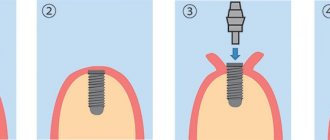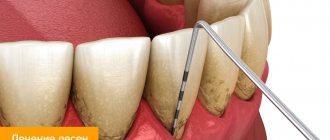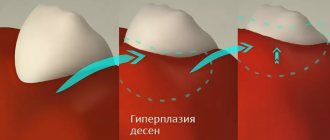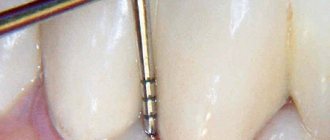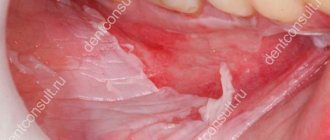Treatment of fibroids on the gum, lip and other soft tissues of the oral cavity, as a rule, involves surgical intervention - removal with a laser or radio wave method. However, in some cases it is possible to do without radical therapy, it depends on the causes of the formation and the ability to quickly eliminate provoking factors.
To make an accurate diagnosis, it is important to undergo a dental examination, consult with a doctor and, if necessary, take a photo of the pathological area. Timely visit to the clinic minimizes the likelihood of complications. In addition, the patient should adhere to preventive measures to prevent the disease and its consequences.
What is fibroma
This is a benign neoplasm in the form of a small node on a stalk or broad base, which consists of fragments of connective tissue. In most cases, it is localized on the mucous membranes of the gums, lips, palate, on the inside of the cheeks, and a little less often on the tongue. The pathological process is more often encountered by primary schoolchildren and adolescents aged 6-15 years.
The patient is not in pain; at a very early stage he does not notice the pathology. As the thickening grows, it is easily felt and accidentally injured.
Can fibroids in the mouth resolve on their own, without medical intervention? In most cases, surgical excision of the tumor is required. However, do not worry about the complexity and duration of the operation. In less than an hour, an experienced doctor will eliminate the defect without subsequent complications and a long rehabilitation period. Currently, clinics use laser and radio wave techniques.
Despite the relative harmlessness of fibrous growths, they still need to be treated even in the absence of discomfort. If the seals increase in size and are constantly exposed to traumatic effects, it is highly likely that an infection will enter the wound. In this case, treatment will be very long, difficult and will not always lead to positive dynamics. In addition, the lack of therapy sometimes leads to the degeneration of a neoplasm into a malignant one.
Reasons for appearance and varieties
Lipoma appears as a result of random division of fat cells. Consists of a capsule and the fat it contains. Rarely, diffuse lipomas occur that randomly grow into healthy tissue. This is a serious reason to contact an oncologist. They can appear anywhere where fatty tissue is present. They tend to grow - some very slowly, and some rapidly.
The reasons for their appearance have not been thoroughly studied, but doctors agreed that the provocateurs of their appearance on the body may be:
- hereditary factor - genetic predisposition;
- poor nutrition, which results in problems with the gastrointestinal tract;
- lack of vitamins and microelements, which is also associated with poor nutrition, especially iron deficiency;
- skin trauma (note to piercing lovers);
- hormonal changes characteristic of adolescents, pregnant women and menopausal women;
- increased levels of “bad” cholesterol in the blood;
- metabolic disorder in the body.
These are the main reasons for the appearance of wen on the lips and other parts of the body.
Lipomas look different. Based on their location and appearance, the following varieties are distinguished:
- angiolipoma – characterized by an abundance of blood vessels;
- fibrolipoma – it contains a lot of connective tissue;
- myxolipoma – characterized by the formation of mucus;
- myolipoma – contains muscle tissue.
Fox-Fordyce granules are often classified as lipomas, which is fundamentally incorrect. The latter are not fatty formations, but in fact they are cysts of the sebaceous glands.
Reasons for education
After conducting numerous studies, scientists have not been able to determine an exhaustive list of factors that provoke the development of pathology. However, some conditions and phenomena still occur most often when diagnosing this disease. For example, this is possible with a hereditary predisposition to fibroids on the gums (shown in the photo below), tongue, inside the cheeks and other areas of the mucous membranes. In this case, the disease develops in childhood in young patients from 1 to 10 years.
Often, in the presence of this diagnosis, a history of regular traumatic exposure is established. There may be constant biting of a certain area of soft tissue. They can also be injured by sharp edges of crowns, orthodontic structures, dentures, especially poorly fixed ones, and hard food.
Taking certain medications can also be a provoking factor. Some medications can cause the appearance of benign lumps in representatives of different age categories, not only in children and adolescents. Drugs that may cause fibromatosis after use:
- Cyclosporine. It is indicated to prevent organ rejection during transplantation.
- Valproate, used by epileptics.
- Verapamil and other calcium channel blockers.
- Estrogens of synthetic origin in oral contraceptives or other hormonal pills.
The culprits in the development of the disease may be inflammatory processes in the oral cavity. These include stomatitis, glossitis, periodontal disease, gingivitis, etc.
It is impossible to exclude a hereditary factor, but the risk of formations can be significantly reduced if you follow simple preventive rules:
- do not forget about hygiene;
- Carry out regular professional cleaning to remove thick plaque and tartar;
- protect soft tissues from traumatic effects (solid food, biting), and also avoid sudden temperature changes;
- treat dental diseases in a timely manner;
- consult with doctors before starting to take medications and avoid self-medication;
- visit the dentist for preventive maintenance at least once every six months.
Treatment of lipomas with pharmaceutical products
Those who prefer to use pharmaceutical drugs should purchase Vishnevsky ointment. This product should be applied to an adhesive plaster and attached to the affected area, after 2 days the plaster should be replaced with a new one.
You can also use hydrogen peroxide. This drug should be regularly lubricated. After a few days, the skin on the affected area will burst and the contents of the wen will leak out.
lipoma treatment
Classification of fibroids
Pathology is divided into several types according to criteria. This includes the density of the benign neoplasm, the nature of its origin, as well as the severity of clinical manifestations.
Dense fibroma
Characterized by a solid consistency. This is due to the fact that the contents are quite hard fibers of connective tissue. They include a small number of cores. Formations of this type are most often found on the gingival surfaces and palate.
Soft fibroma
The fibrous structures are thin and freely located, so their clusters are characterized by a high degree of softness. This type is most often observed on the tongue and the inside of both cheeks. Benign neoplasms of a mixed type, combining the signs of all the varieties listed above, can be found on the sublingual part and on the mucous membranes of the floor of the oral cavity. For example it could be:
- Fibrolipoma. It is hard to the touch because it contains fibrous fibers. It can be eliminated surgically, with laser, or radio waves.
- Fibrohemangioma. As a rule, it is provoked by infectious processes occurring in the child’s body. It is extremely rare in adults. It never degenerates into malignant tumors. Most often it is treated surgically, in some cases it can resolve on its own.
Fibroma from irritation
This is not a tumor formation in its usual form, but the result of reactive hyperplasia. Chronic pathology is characterized by the development of focal lesions, which are caused by systematic mechanical action and subsequent injury.
The most common cause is installed crowns, fillings, and dentures. In the latter case, the disease is called prosthetic granuloma. The orthopedic structure exerts continuous pressure on the alveolar process, leads to its resorption, moves forward and contributes to the formation of compactions, which are associated with the inflammatory process.
The risk group includes not only patients who have undergone prosthetics, but also people with untimely cured caries, in adulthood, with foreign objects in the oral cavity (for example, with piercings). Studies have shown that women are more prone to such hypertrophic transformations than men.
Symmetrical fibromas
Doctors diagnose such tumors in the area of the third molars in the areas between the gums and the roof of the mouth. The tumor is hard to the touch and resembles a bean in shape.
It should be noted that this type of compaction does not apply to true fibromatosis. These are just overgrown tissues in the gingival membranes, accompanied by the process of scarring and other changes of a similar nature.
Lobular fibroma
It occurs as a result of reactive hyperplasia with systematic trauma to delicate sensory fibers with prostheses or other orthopedic structures. The main distinguishing feature of such formations is their rough, textured surface. When palpated, tubercles are felt.
Fibrous epulis
This is a dense growth of pinkish tissue that does not cause pain or other discomfort. The edges are often hyperemic, have clear boundaries and irregular shape. The base is quite wide.
The vestibular part of the gums is usually affected. There are cases of neoplasms occurring in the interdental spaces in the form of a saddle with spread to the intraoral surface.
Quite often, a dental unit located in a pathological area has a poorly fitted metal crown, extensive carious lesions, or a prosthetic clasp. It is these structures that are the provoking factor in the occurrence of a chronic inflammatory process with the formation of granules, which over time are transformed into mature connective fibrous fibers.
In dentistry, there are also angiomatous epulis. They are brighter in color, somewhat softer to the touch and bleed. In this case, blood appears not only at those moments when the surface is affected mechanically, but regardless of the presence or absence of a traumatic factor. When conducting diagnostic studies, many vascular branches are detected in the pathological area.
Rehabilitation period after lipoma removal
Depending on the size of the lipoma, its location and the complexity of classical surgical removal, the length of hospital stay can be 1–3 days. After laser removal of a small tumor, the patient can go home immediately after the procedure. If non-absorbable sutures were applied during the operation, they are removed after 7 to 10 days. Within a week, the wound heals completely. During this time, it is necessary to avoid exposure of the removal site to sunlight and water.
Symptoms
The tumor grows and develops quite slowly, so for a long time the patient may not even be aware of its presence in the mouth. Fibroma of the oral mucosa looks like a hemispherical growth rising above the plane, covered with pinkish tissue. If you press it, pain or other discomfort does not appear. The surface is smooth, there are no irregularities or roughness on it.
The appearance of ulcers with such a diagnosis is very rare. In such cases, an infection is usually associated with the subsequent development of the inflammatory process. Swelling, redness, erosion occur, and pain is felt. The pain persists even if you do not touch the pathological area.
If you do not injure the formation, it may not change its size for quite a long time and remain in a stable state. If it is exposed to constant traumatic effects, there is a high risk of malignant degeneration, which is dangerous to the life and health of the patient.
How is a lipoma removed?
Treatment begins with diagnosis. The doctor conducts a visual examination, determines the size, structure and shape of the formation. In order to understand what effect the lipoma has on surrounding tissues, an ultrasound examination is performed. If the lipoma is localized in a potentially dangerous area, an MRI or CT scan may be prescribed.
The lipoma removal procedure itself begins with the administration of anesthesia. In classic surgical removal of a tumor, the surgeon performs an excision, that is, makes a small incision, then cuts out the fatty tissue along with the capsule in which it is contained. At the final stage, the tissues are sutured using self-absorbing sutures, and an antiseptic bandage is applied.
For laser removal, local anesthesia is most often used. The directed laser beam simultaneously performs two functions: a coagulator and a scalpel. Laser removal is bloodless, healing is faster, and the risk of swelling is significantly reduced.
Diagnosis of fibroids of the upper and lower jaw
The doctor will not prescribe treatment until he is sure that the diagnosis is correct. To do this, diagnostic procedures are carried out, the results of which will confirm or refute the fears of doctors.
First, the patient is asked to describe the symptoms. The dentist examines and palpates the tumor. However, this is not enough to develop therapeutic tactics, since it is extremely important to determine the depth of tumor growth into soft tissue. For this purpose, an ultrasound examination is performed.
In difficult cases (ulcers, development of an inflammatory process in a pathological area of the gum, etc.), a biopsy is indicated. After surgical removal of the tumor, fragments are necessarily sent for histological analysis.
The examination is necessary not only to establish a diagnosis, but also to identify the factors that provoked the disease. A full dental examination is carried out to confirm the presence of inflammation. In addition, one cannot do without radiography, orthopantomogram and other images in different projections.
If a person has dentures, a consultation with an orthopedic dentist may be necessary. This is necessary to eliminate the possible traumatic effects of artificial elements on the mucous membranes.
Differential diagnosis
Biopsy remains one of the most informative methods for distinguishing fibroids from other benign neoplasms. The study is indicated for suspected papilloma, lipoma, epulis of various structures, neurofibroma, cyst, squamous cell carcinoma, wart, etc.
If the growth is localized on the tongue or sublingual part, it is extremely important to differentiate it from all existing seals. Timely diagnostic measures make it possible to detect cancer at the earliest stages and provide high-quality therapy with a short recovery period.
Prevention
The possibility of developing a lipoma on the lip can be reduced to a minimum by following recommendations for the prevention of pathology, which include:
- Rejection of bad habits.
- Compliance with personal hygiene rules.
- Using high quality cosmetics.
- Providing a balanced diet.
When a lipoma is first detected, you cannot mask the defect with permanent makeup, which can cause infection of the affected tissue. Attempts to squeeze out or cut off the wen yourself are strictly prohibited.
If the appearance of fatty growths is associated with internal diseases, therapy should be carried out under the strict supervision of a doctor. The appearance of wen in the lip area can be not only a facial defect, but also a signal of a dangerous pathology of the body that requires urgent treatment.
Treatment of oral fibroids
Surgery remains the most effective and most common therapeutic method. The seal is excised using a laser or radio waves. This procedure lasts about half an hour. If the tumor is very large, after its removal the wound is covered with a flap, which is formed by the doctor from the surrounding tissue.
When pathology is caused by taking certain medications, they should be completely eliminated and replaced with alternatives with similar properties. After discontinuation of drugs in such cases, the appearance of the mucous membranes is often restored without outside help, and the likelihood of relapse approaches zero. However, this does not apply to situations where the disease is advanced.
Surgery can also be avoided in case of traumatic effects of orthopedic structures. For example, when a crown, filling, or prosthesis puts pressure on the tissue. Elimination of the provoking factor often leads to a decrease or complete disappearance of a benign formation. Most likely, it will be necessary to dismantle the old structures and replace them with new ones.
On the Internet you can find stories of healing using home remedies. It is worth remembering that the disease cannot be treated with the help of folk recipes. Herbal decoctions and infusions, and other compositions are used only as an auxiliary element of complex therapy.
Preventive measures
Since after removal of the wen it can reappear, it is important to follow a number of simple rules to avoid recurrence. These rules will help healthy people prevent the development of wen. The first and basic principle that will help prevent the appearance of bulging formations is nutritional control. It is important to adhere to a healthy and balanced menu, in which fatty foods are limited. Doctors recommend leading an active lifestyle and taking walks in the fresh air more often. It is important to monitor your immune system and take vitamin and mineral complexes in winter and autumn.
In addition, special attention should be paid to lip hygiene. It is recommended to use hygienic lipstick daily, which will relieve dryness and tightness of the lips. It is important to use only high-quality and proven cosmetics, since products containing bad components can clog pores, causing wen. It would also be useful to perform a facial massage in the nasolabial area. This will help increase blood circulation. If the wen has already appeared, it is under no circumstances recommended to squeeze it out. Squeezing is fraught with infection, so patients often note that the wen is inflamed inside. In this case, it is important to go to the doctor and treat lipomas using the medications that will be prescribed.
Let's sum it up
Mucous fibroids on the inside of the cheeks, gums, lips, and tongue grow very slowly and do not cause severe discomfort. They do not pose a danger to the patient, but the problem must be eliminated as early as possible. The fact is that a benign seal in the oral cavity with regular trauma can degenerate into a malignant one, and the oncological process requires serious therapy and is extremely dangerous to life and health.
It is impossible to get rid of the disease using traditional methods. It is important to undergo high-quality dental diagnostics and consult with specialists. In most cases, surgical excision is indicated, but with small growths, the absence of severe symptoms and the elimination of provoking factors, there is a possibility of rapid tissue restoration without external influence.
There is no need to worry if the doctor has decided to undergo surgery. Modern clinics practice laser or radio wave removal on an outpatient basis. These are the most gentle and highly effective methods. An extremely important point in a positive prognosis for the treatment of dental fibroids is an early visit to a doctor and proper excision by an experienced physician.
How to get rid of wen on lips
In most cases, whether to get rid of lipomas on the lips or not is decided by the carrier of these tumors. The doctor's indications for removal may be due to several reasons - rapid growth, as well as pain and bleeding.
In all other cases, this is considered a cosmetic defect. Since this defect is obvious, many people prefer to get rid of it. There are two approaches to how to remove wen on the lip:
- Carry out the operation in a medical facility after a thorough examination.
- Try to cope with folk remedies.
The first method of treatment is correct and reasonable, but the second is dubious and sometimes downright dangerous.
Medical and cosmetic procedures
It should be immediately clarified that the removal of wen from the lips for medical reasons, as well as in order to eliminate a cosmetic defect, is carried out only in medical institutions, with the help of modern equipment, by qualified doctors.
Do not contact a cosmetologist with this problem if you do not want to have major health problems in the future when the treatment takes a long time. This is not the profile of cosmetologists.
Wen, like a new growth on the lip, is rarely ignored. Everyone is in a hurry to get rid of him. It is better to do this in a medical facility.
For cosmetic purposes, wen is removed in two ways:
- Injection - a medicinal product is injected with a syringe into the capsule of the wen. After some time, the lipoma on the lip resolves.
- Removing a lipoma using radiofrequency radiation involves treating the wen with a device, then the capsule is removed and sent for histology. The crust formed in this case disappears after a few days, leaving no trace.
For medical reasons, for therapeutic purposes, wen is removed using the following methods:
- If the wen is large, then it is excised with a scalpel. To do this, an incision is made in the skin. The edges of the incision are opened with special devices, and the wen capsule with its contents is cut out. The wound is treated with an antiseptic and stitches are applied.
- Laser removal of wen is the most preferred procedure in many respects. It is bloodless, because after cauterization the vessels are sealed, leaves no marks and does not cause relapses.
Traditional methods
Wen began to appear on the human body long before the advent of a scalpel, let alone laser equipment. And people tried to get rid of them, sometimes even successfully. But we must remember that our ancestors had no alternative, but we have one. Therefore, before moving on to traditional methods, think carefully about the consequences.
What do folk recipes offer in the fight against wen:
- Clay applications are the most harmless manipulation of lip wen. Clay diluted with warm water is applied to the lipoma affected lip for 10-15 minutes and washed off with warm water. Applications are carried out until the lipoma is reabsorbed.
- Cut three-year-old aloe and keep it on the bottom shelf of the refrigerator for a week. Then, cutting the aloe leaf lengthwise, apply the juicy side to the lip and secure with a band-aid. Do this procedure until the wen disappears. The longer the leaf is on the lips, the better.
- Spread the wen with hot lamb fat and repeat the procedure for 5-7 days. There is evidence that the wen disappeared on the 3rd day.
- Crushed fresh garlic is mixed with olive oil and the mixture is applied to the lips until the lipomas disappear.
- Moisten a cotton swab with aloe or Kalanchoe juice and apply to the wen as often as possible. Do it for several days in a row.
- You need to rub jojoba oil into the lipoma every day until it disappears.
Here are several methods of getting rid of wen on the lips using traditional medicine. We have listed the most harmless of them.
Effect of lipoma removal
Removing the capsule containing the fatty tissue minimizes the risk of disease recurrence, unlike alternative lipoma excision techniques. After surgical excision of a large formation, a small scar remains, which, in agreement with the doctor, can be made less noticeable using special creams/ointments and hardware procedures. As noted earlier, laser removal does not leave scars or scars, which is especially important for the patient when the formation is localized on the face/head/neck.
